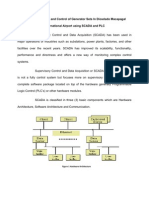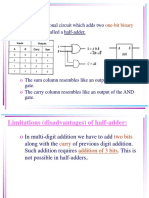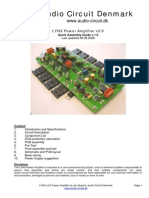Copy of PLC EXPERIMENT 6
Copy of PLC EXPERIMENT 6
Uploaded by
Anonymous DtXw1wCopyright:
Available Formats
Copy of PLC EXPERIMENT 6
Copy of PLC EXPERIMENT 6
Uploaded by
Anonymous DtXw1wOriginal Title
Copyright
Available Formats
Share this document
Did you find this document useful?
Is this content inappropriate?
Copyright:
Available Formats
Copy of PLC EXPERIMENT 6
Copy of PLC EXPERIMENT 6
Uploaded by
Anonymous DtXw1wCopyright:
Available Formats
DEPARTMENT OF ELECTRICAL ENGINEERING
Experiment No. 06
Date:____________
Title: PLC interfaced with SCADA & status read/command transfer operation.
Aim: To develop the ladder diagram in PLC and interface with SCADA and perform on of
operation in SCADA.
PLC trainer Kit: Equipment:
1.
Advanced PLC trainer Kit Allen Bradley Micrologix 1400
2.
Ladder programming software (RsLogix 500 English by AB)
3.
Communication Cable (any Ethernet Cross Cable)
4.
PC
5.
SCADA programming software( iFIX 5.0)
Advanced PLC trainer Kit:
Allen Bradley MicroLogix 1400 series 1766-L32BXB PLC with 12 Fast 24V DC Inputs,
8 Normal 24V DC Inputs, 6 Relay Outputs, 3 Fast DC Outputs, 3 Normal DC Outputs, Start,
Stop and input simulation switches, proxy sensors and lamps for outputs. 230VAC mains MCB.
Provision to connect computer via Ethernet communication port. MS fabricated, Orange Colour
powder coated frame.
DEPARTMENT OF ELECTRICAL ENGINEERING
What does SCADA mean?
SCADA stands for Supervisory Control And Data Acquisition. As the name indicates, it
is not a full control system, but rather focuses on the supervisory level. As such, it is a purely
software package that is positioned on top of hardware to which it is interfaced, in general via
Programmable Logic Controllers (PLC's), or other commercial hardware modules.
SCADA systems are used not only in industrial processes but also in some experimental
facilities such as nuclear fusion. The size of such plants range from a few 1000 to several 10
thousands input/output (I/O) channels. However, SCADA systems evolve rapidly and are now
penetrating the market of plants with a number of I/O channels of several 100 thousands I/O's
1. Architecture
This
section
describes
the
common
Hardware Architecture
features
of
the
SCADA
products.
DEPARTMENT OF ELECTRICAL ENGINEERING
One distinguishes two basic layers in a SCADA system: the "client layer" which caters
for the man machine interaction and the "data server layer" which handles most of the
process data control activities.
Figure 1: Typical Hardware Architecture
Software Architecture
The products are multi-tasking and are based upon a real-time database (RTDB) located
in one or more servers. Servers are responsible for data acquisition and handling (e.g. polling
controllers, alarm checking, calculations, logging and archiving) on a set of parameters, typically
those they are connected to.
DEPARTMENT OF ELECTRICAL ENGINEERING
Figure 2: Generic Software Architecture
However, it is possible to have dedicated servers for particular tasks, e.g. historian,
datalogger, alarm handler. The figure above shows a generic SCADA software architecture.
Communications
Internal Communication:
Server-client and server-server communication is in general on a publish-subscribe and
event-driven basis and uses a TCP/IP protocol, i.e., a client application subscribes to a parameter
which is owned by a particular server application and only changes to that parameter are then
communicated to the client application.
Access to Devices:
The products provide communication drivers for most of the common PLC's and widely
used field-buses, e.g., Modbus. Some of the drivers are based on third party products (e.g.,
Applicom cards) and therefore have additional cost associated with them. VME on the other
hand is generally not supported.
A single data server can support multiple communications protocols: it can generally
support as many such protocols as it has slots for interface cards.
DEPARTMENT OF ELECTRICAL ENGINEERING
Interfacing
Application Interfaces / Openness:
The provision of OPC client functionality for SCADA to access devices in an open and
standard manner is developing.
The products also provide an Open Data Base Connectivity (ODBC) interface to the data
in the archive/logs, The API often does not provide access to the product's internal features such
as alarm handling, reporting, trending, etc.
The PC products provide support for the Microsoft standards such as Dynamic Data
Exchange (DDE) which allows e.g. to visualize data dynamically in an EXCEL spreadsheet,
Dynamic Link Library (DLL) and Object Linking and Embedding (OLE).
Database:
The configuration data are stored in a database that is logically centralized but physically
distributed and that is generally of a proprietary format. The archive and logging format is
usually also proprietary for performance reasons, but some products do support logging to a
Relational Data Base Management System (RDBMS) at a slower rate either directly or via an
ODBC interface.
Scalability
The products achieve scalability by having multiple data servers connected to multiple
controllers. Each data server has its own configuration database and RTDB and is responsible for
the handling of a sub-set of the process variables (acquisition, alarm handling, archiving).
Redundancy
The products often have built in software redundancy at a server level, which is normally
transparent to the user.
2. Functionality
DEPARTMENT OF ELECTRICAL ENGINEERING
Access Control
Users are allocated to groups, which have defined read/write access privileges to the
process parameters in the system and often also to specific product functionality.
MMI
The products support multiple screens, which can contain combinations of synoptic
diagrams and text.
Most of the SCADA products that were evaluated decompose the process in "atomic"
parameters (e.g. a power supply current, its maximum value, its on/off status, etc.) to which a
Tag-name is associated. The Tag-names used to link graphical objects to devices can be
edited as required. The products include a library of standard graphical symbols.
Standard windows editing facilities are provided: zooming, re-sizing, scrolling... On-line
configuration and customization of the MMI is possible for users with the appropriate
privileges. Links can be created between display pages to navigate from one view to another.
Trending
The products all provide trending facilities and one can summarize the common
capabilities as follows:
The parameters to be trended in a specific chart can be predefined or defined on-line
a chart may contain more than 8 trended parameters or pens and an unlimited number of
charts
can
be
displayed
(restricted
only
by
the
readability)
real-time and historical trending are possible, although generally not in the same chart
historical
trending
zooming
parameter
is
and
values
possible
scrolling
at
the
for
any
functions
cursor
position
archived
parameter
are
provided
can
be
displayed
Alarm Handling
Alarm handling is based on limit and status checking and performed in the data servers.
The alarms are logically handled centrally, i.e., the information only exists in one place and
DEPARTMENT OF ELECTRICAL ENGINEERING
all users see the same status (e.g., the acknowledgement), and multiple alarm priority levels
(in general many more than 3 such levels) are supported.It is possible to suppress alarms
either individually or as a complete group. The filtering of alarms seen on the alarm page or
when viewing the alarm log is also possible at least on priority, time and group.
Logging/Archiving
Logging can be thought of as medium-term storage of data on disk, whereas archiving is
long-term storage of data either on disk or on another permanent storage medium. Logging is
typically performed on a cyclic basis. Logged data can be transferred to an archive once the
log is full. The logged data is time-stamped and can be filtered when viewed by a user.
Report Generation:
One can produce reports using SQL type queries to the archive, RTDB or logs. Although
it is sometimes possible to embed EXCEL charts in the report. Facilities exist to be able to
automatically generate, print and archive reports.
Automation
The majority of the products allow actions to be automatically triggered by events. A
scripting language provided by the SCADA products allows these actions to be defined.
The concept of recipes is supported, whereby a particular system configuration can be saved
to
file
and
then
re-loaded
at
later
date.
Sequencing is also supported whereby, as the name indicates, it is possible to execute a
more complex sequence of actions on one or more devices.
3. Application Development
Configuration
The development of the applications is typically done in two stages. First the process
parameters and associated information (e.g. relating to alarm conditions) are defined through
DEPARTMENT OF ELECTRICAL ENGINEERING
some sort of parameter definition template and then the graphics, including trending and
alarm displays are developed, and linked where appropriate to the process parameters.
Development Tools
The
following
development
tools
are
provided
as
standard:
Graphics Editor, with standard drawing facilities including freehand, lines, squares circles,
etc. It is possible to import pictures in many formats as well as using predefined symbols
including e.g. trending charts, etc. A library of generic symbols is provided that can be linked
dynamically to variables and animated as they change. It is also possible to create links
between views so as to ease navigation at run-time.
Database Configuration Tool (usually through parameter templates). It is in general
possible to export data in ASCII files so as to be edited through an ASCII editor or Excel.
Scripting Language
Application
Program
Interface
(API)
supporting
C,
C++,
VB
Driver Development Toolkit to develop drivers for hardware that is not
Supported by the SCADA product.
4. Evolution
SCADA vendors release one major version and one to two additional minor versions
once per year. These products evolve thus very rapidly so as to take advantage of new market
opportunities, to meet new requirements of their customers and to take advantage of new
technologies.
As was already mentioned, most of the SCADA products that were evaluated decompose
the process in "atomic" parameters to which a Tag-name is associated. This is impractical in
the case of very large processes when very large sets of Tags need to be configured. As the
industrial applications are increasing in size, new SCADA versions are now being designed
to handle devices and even entire systems as full entities (classes) that encapsulate all their
specific attributes and functionality. In addition, they will also support multi-team
development.
DEPARTMENT OF ELECTRICAL ENGINEERING
As far as new technologies are concerned, the SCADA products are now adopting:
Web technology, ActiveX, Java, etc.
OPC as a means for communicating internally between the client and server modules. It
should thus be possible to connect OPC compliant third party modules to that SCADA
product.
Procedure:
A) Precautions:
1. Ensure following points for proper functioning of the trainer.
2. Mains supply is 230VAC 10% 50HZ.
3. All input simulation switches are in off position [Toggle to Down side ],
4. At power ON, no any module is interfaced or cables are connected.
5. Mains MCB switch is OFF.
B) Experimental Procedure:
1. Ensure mains supply is 230VAC 10% 50HZ.
2. Connect the mains cable and turn ON the Mains MCB.
3. Ensure the power ON LED on the PLC module lit.
4. Toggle the input simulation switches and observe the appropriate input block lit on LCD.
5. Those operation you have performed in PLC -SCADA,& define related tag in IGS
6.
Open IGS ---> Select channel 1----> Select device 1 ----> Click right button on mouse &
define NEW tag ---->Define tag name in identification - name block (e.g.start,stop,on,off etc)
----> Define tag address (e.g. B3:0/n, n =1,2,3..20)----->Apply ----> Ok ----> Save this
tag in PLC
7. Develop application related Ladder diagram in PLC
8. Open iFIX SCADA 5.5----> click tool bar application ----> open Data base manager ---->
open local node ----> ok ----> define same tag in PLC to SCADA ----> Save this tag in SCADA
DEPARTMENT OF ELECTRICAL ENGINEERING
----> Close data base manager -----> open dynamo set in home screen ----> drag to appropriate
application
----> open new picture ----> Define appropriate tag related application in iFIX SCADA 5.0
9. Run SCADA
C) Shut down procedure:
1. Disconnect all interfacing modules/ devices.
2. Switch off mains and remove mains cable.
3. Store the trainer along with all accessories in safe custody.
Questions:
1) To develop ladder diagram of Lamp & push button operation with start & stop operation.
Conclusion:
10
You might also like
- SCADA - Beginner - S GuideDocument58 pagesSCADA - Beginner - S GuidescribddderNo ratings yet
- Scada: S.Anbu Kaviraj & M. Mahendhiran Government College of Engineering Tirunelveli-627007Document7 pagesScada: S.Anbu Kaviraj & M. Mahendhiran Government College of Engineering Tirunelveli-627007Dinesh DinuNo ratings yet
- Scada PaperDocument6 pagesScada PaperhafizgNo ratings yet
- Remote Monitoring and Control of Generator Sets in Diosdado Macapagal International Airport Using SCADA and PLCDocument9 pagesRemote Monitoring and Control of Generator Sets in Diosdado Macapagal International Airport Using SCADA and PLCromer88No ratings yet
- Scada: SupervisionDocument5 pagesScada: SupervisionFaishal Robby LuqmanNo ratings yet
- Controledge Hc900 - Version 7.2: 1 Software OverviewDocument8 pagesControledge Hc900 - Version 7.2: 1 Software OverviewNanang Roni WibowoNo ratings yet
- A Comparison of PACs To PLCsDocument3 pagesA Comparison of PACs To PLCskouki982hotmailcomNo ratings yet
- SCADA-WorldView Applications GuideDocument4 pagesSCADA-WorldView Applications GuideMichael June AgitoNo ratings yet
- Scada: Seminar Report OnDocument12 pagesScada: Seminar Report OnjithinNo ratings yet
- Bu34p2a00 01eDocument7 pagesBu34p2a00 01eAlex AlvesNo ratings yet
- Tech Note 671 - Optimizing IO Performance in System PlatformDocument13 pagesTech Note 671 - Optimizing IO Performance in System PlatformsimbamikeNo ratings yet
- IEC61131 Logic For SCADA Optomization Entelec PaperDocument6 pagesIEC61131 Logic For SCADA Optomization Entelec PaperSurachet Pavanne100% (1)
- Modbus Source Code LibrariesDocument4 pagesModbus Source Code LibrariesSocaciu VioricaNo ratings yet
- Iec61131 Letter Cmi v005Document3 pagesIec61131 Letter Cmi v005Juan Abdón Sepúlveda GarridoNo ratings yet
- Supervisory Control and Data Acquisition (SCADA) : July 2017Document24 pagesSupervisory Control and Data Acquisition (SCADA) : July 2017Royal Ritesh SharmaNo ratings yet
- Openenterprise: New Capability of Integrating Dcs and Scada Client / Server ArchitectureDocument20 pagesOpenenterprise: New Capability of Integrating Dcs and Scada Client / Server Architectureilie_vlassaNo ratings yet
- IAS 2.0 Features and BenefitsDocument6 pagesIAS 2.0 Features and Benefitsgayuh_permanaNo ratings yet
- SCADADocument5 pagesSCADARubayaNo ratings yet
- DCS System Layout and Its Different PartsDocument6 pagesDCS System Layout and Its Different PartsVraja Kisori100% (1)
- Whitepaper Substation Automation Schneider ElectricDocument5 pagesWhitepaper Substation Automation Schneider Electricsahil4INDNo ratings yet
- Integration Techniques of The Embedded Distributed Systems Using Programming Environments and Industrial Standard Communication ProtocolsDocument12 pagesIntegration Techniques of The Embedded Distributed Systems Using Programming Environments and Industrial Standard Communication ProtocolsSabine CrihanNo ratings yet
- Adv Instr Lecture 3Document67 pagesAdv Instr Lecture 3Rayees Khan TareenNo ratings yet
- Siemens Simatic S7-400 System in A Rack, Left-To-Right: Power Supply Unit (PSU), CPU, Interface Module (IM) and Communication Processor (CP)Document11 pagesSiemens Simatic S7-400 System in A Rack, Left-To-Right: Power Supply Unit (PSU), CPU, Interface Module (IM) and Communication Processor (CP)Kishore Steve AustinNo ratings yet
- Control System: Types of Industrial Control SystemsDocument19 pagesControl System: Types of Industrial Control SystemsAdnan Nawaz100% (5)
- Outcome 2 (Programming) PDFDocument19 pagesOutcome 2 (Programming) PDFDon de la CruzNo ratings yet
- Power Generation Portal ABBDocument20 pagesPower Generation Portal ABBCristian TilinschiNo ratings yet
- Industrial Automation Unit V: Prepared By: Pradnya SadigaleDocument31 pagesIndustrial Automation Unit V: Prepared By: Pradnya Sadigalepradnya sadigaleNo ratings yet
- 5 Ingredients That Make Scada Operation Delicious: Scada, Rtus, PLCS, ServersDocument18 pages5 Ingredients That Make Scada Operation Delicious: Scada, Rtus, PLCS, ServersAkram AshmawyNo ratings yet
- 3 CopalpDocument4 pages3 Copalpvgq47eplkyy8No ratings yet
- ICT-REVIEWERDocument4 pagesICT-REVIEWEREq McfastNo ratings yet
- iFIX Database WhitepaperDocument6 pagesiFIX Database WhitepaperjavierleraNo ratings yet
- What Are Scada Systems Able To DoDocument14 pagesWhat Are Scada Systems Able To DoHocine Meng FodilNo ratings yet
- 60 Series: Weight-Based Indicators & ControllersDocument6 pages60 Series: Weight-Based Indicators & ControllersDavid RodriguezNo ratings yet
- PID Control Theory TutorialDocument12 pagesPID Control Theory TutorialArnab Aditya SethiNo ratings yet
- User ManualDocument420 pagesUser Manualbitx.kisNo ratings yet
- Webaccess ManualDocument10 pagesWebaccess Manualdedy250591No ratings yet
- Untitled PresentationDocument14 pagesUntitled Presentationshinumann20No ratings yet
- Siemens s7-300 ProgrammingDocument94 pagesSiemens s7-300 ProgrammingPrittam Kumar Jena100% (7)
- ScadaDocument20 pagesScadaMandeep G KashyapNo ratings yet
- Solve Acwp Ct-IIDocument8 pagesSolve Acwp Ct-IIfoysalmehadi131No ratings yet
- 6 - DCS IapcDocument14 pages6 - DCS IapcNikita ChaudhariNo ratings yet
- Automated Solution For Data Monitoring (Dashboard) of ASIC Design FlowDocument4 pagesAutomated Solution For Data Monitoring (Dashboard) of ASIC Design FlowseventhsensegroupNo ratings yet
- Scada: (Supervisory Control and Data Acquisition)Document18 pagesScada: (Supervisory Control and Data Acquisition)ajay_kairiNo ratings yet
- CoDeSysdevelopmentS W PDFDocument4 pagesCoDeSysdevelopmentS W PDFThanh BaronNo ratings yet
- SCADAvantage Network Topology System Software ProductsDocument8 pagesSCADAvantage Network Topology System Software ProductsKwameOpareNo ratings yet
- Automation ABB (PLC)Document68 pagesAutomation ABB (PLC)Alfiansyah Dharma Setia DjaketraNo ratings yet
- Connecting To Allen-BradleyDocument16 pagesConnecting To Allen-Bradleycjutp86No ratings yet
- Automation Software Concept v2.6Document8 pagesAutomation Software Concept v2.6Iz MaxxNo ratings yet
- Universidad Tecnologica de DurangoDocument6 pagesUniversidad Tecnologica de DurangoVictor CenicerosNo ratings yet
- IEC 61850 Source Code LibrariesDocument7 pagesIEC 61850 Source Code LibrariesHameedNo ratings yet
- Voice Controlled Wheel ChairDocument48 pagesVoice Controlled Wheel ChairAjith manjuNo ratings yet
- MT6603 DMS Unt 3 PDFDocument39 pagesMT6603 DMS Unt 3 PDFKarthi KeyanNo ratings yet
- Conveyor Control Using Programmable Logic ControllerDocument7 pagesConveyor Control Using Programmable Logic ControllerWann RexroNo ratings yet
- PLC: Programmable Logic Controller – Arktika.: EXPERIMENTAL PRODUCT BASED ON CPLD.From EverandPLC: Programmable Logic Controller – Arktika.: EXPERIMENTAL PRODUCT BASED ON CPLD.No ratings yet
- PLC Programming Using RSLogix 500 & Industrial Applications: Learn ladder logic step by step with real-world applicationsFrom EverandPLC Programming Using RSLogix 500 & Industrial Applications: Learn ladder logic step by step with real-world applicationsRating: 5 out of 5 stars5/5 (1)
- Google Cloud Platform for Data Engineering: From Beginner to Data Engineer using Google Cloud PlatformFrom EverandGoogle Cloud Platform for Data Engineering: From Beginner to Data Engineer using Google Cloud PlatformRating: 5 out of 5 stars5/5 (1)
- WSM-5 Electrical MachineDocument4 pagesWSM-5 Electrical MachineBABAKNo ratings yet
- Half-Adder:: One-Bit Binary NumbersDocument6 pagesHalf-Adder:: One-Bit Binary NumbersKiran AbbasNo ratings yet
- DVM PLUS3 2 Indoor UnitsDocument76 pagesDVM PLUS3 2 Indoor UnitsSattar Al-JabairNo ratings yet
- Digital Communication & Information Theory Course Code TC-311Document18 pagesDigital Communication & Information Theory Course Code TC-311Maryam MuneebNo ratings yet
- 500WLaser Mold Welding Machine ManualDocument19 pages500WLaser Mold Welding Machine ManualphukaifrNo ratings yet
- Admission Examination Sample EnglishDocument19 pagesAdmission Examination Sample Englishwessam_mrNo ratings yet
- MCQ of Electrical MachinesDocument78 pagesMCQ of Electrical Machineskibrom atsbha100% (2)
- LynxDocument11 pagesLynxselfmake1523No ratings yet
- Mercedes (DTC) 986390916500 20240308165327Document2 pagesMercedes (DTC) 986390916500 20240308165327Yankho NalimaNo ratings yet
- Project 1 Pre-AMPDocument6 pagesProject 1 Pre-AMPEngkiong Go100% (1)
- SoftTH Thread MeDocument10 pagesSoftTH Thread MeDaan van der SpekNo ratings yet
- 555 Timers With PSpice LabDocument6 pages555 Timers With PSpice LabHatem MOKHTARI0% (1)
- Icom IC-M700 Service ManualDocument107 pagesIcom IC-M700 Service ManualYayok S. Anggoro96% (24)
- Design of Single Phase Inverter Using Dspic30F4013: Mr. R.SenthilkumarDocument7 pagesDesign of Single Phase Inverter Using Dspic30F4013: Mr. R.SenthilkumarsureshhdreamNo ratings yet
- Elmasri 6e Ch21Document54 pagesElmasri 6e Ch21Marwan Aly MohamedNo ratings yet
- Boiler IgnitionDocument16 pagesBoiler IgnitionS SanchitNo ratings yet
- Samwha Capacitor Full CatalogDocument68 pagesSamwha Capacitor Full Catalograyyan2007No ratings yet
- Green Wire ControversyDocument3 pagesGreen Wire ControversycoryusNo ratings yet
- Security System Based On Stepper Motor Control Using Micro ControllerDocument6 pagesSecurity System Based On Stepper Motor Control Using Micro ControllerARVINDNo ratings yet
- HD61Z456 SchematicsDocument105 pagesHD61Z456 SchematicsTonimarie MilewskiNo ratings yet
- Mcac TSM 2008 02Document94 pagesMcac TSM 2008 02Eng . Moiead SlemanNo ratings yet
- TOA Vm3000 Operate eDocument149 pagesTOA Vm3000 Operate eCristianLeotescuNo ratings yet
- Pdfen Iris - Asansor.kumanda - Karti 1428913151Document21 pagesPdfen Iris - Asansor.kumanda - Karti 1428913151Mohd Abu AjajNo ratings yet
- InstructionsDocument6 pagesInstructionsqqaqqNo ratings yet
- RS-232/RS-485/RS-422 UT-216 Interface Converter User Manual: I. SummaryDocument2 pagesRS-232/RS-485/RS-422 UT-216 Interface Converter User Manual: I. SummaryNurwikan AdiwinotoNo ratings yet
- Scotle Technology Group Ltd. Scotle IR6000 V3. BGA Rework Station. User Manual.Document17 pagesScotle Technology Group Ltd. Scotle IR6000 V3. BGA Rework Station. User Manual.zigmund zigmundNo ratings yet
- 178-The IT Earthing SystemDocument31 pages178-The IT Earthing Systemgeorgel1980No ratings yet
- Manual de Sony VaioDocument32 pagesManual de Sony VaioWmer EscNo ratings yet
- Industrial Monitoring System Using PLCDocument3 pagesIndustrial Monitoring System Using PLCshubham thakur50% (2)
- Dell Latitude E5550 / 5550 Owner's Manual: Regulatory Model: P37F Regulatory Type: P37F001Document62 pagesDell Latitude E5550 / 5550 Owner's Manual: Regulatory Model: P37F Regulatory Type: P37F001Eduard PopescuNo ratings yet

























































































